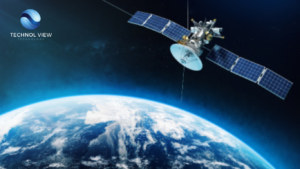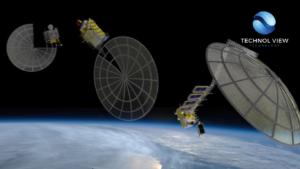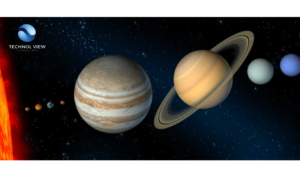What Is Space Technology?
Space technology takes people on a journey through space, where they can explore new things and learn important things about the universe. In ancient times, looking up at the night sky was just for fun. But now, the complex web of technological advances pushes us towards faraway worlds, creating a story of multiple complexity within the emptiness of the universe. This conversation takes a deep dive into the many facets of space technology, navigating through the mystery of what it is, the winding paths of its uses, the heavenly dance it creates with space studies, the ethereal assumptions it breaks, and the cosmic symphony that echoes in its future plans.

Coverage Of Space Technology:
Space technology covers a huge area and offers a wide range of new ideas that are meant to help with exploring, using, and understanding space. A cosmic carnival, with sentinel satellites orbiting Earth and brave rovers exploring the surface of Mars. Space telescopes allow us to look into other worlds, and spacecraft speed through the universe. All of this is orchestrated by engineering, physics, computer science, and many other scientific fields that are woven into the fabric of the universe.
Planetary Space:
Planetary space is now part of the cosmic dance, with satellite communication as the main dancer. Being in geostationary orbit, these guardians make it easier for people all over the world to talk to each other. They cast a spell that makes everyday things seem magical, from TV shows to the airy dance of an internet connection. But space technology is much more than just a way to talk to each other. It also keeps a close eye on the atmospheric dance, planning complex moves for weather forecasting, tracking systems, and the careful handling of disasters.
Satellites With High-Tech Cameras:
Satellites with high-tech cameras paint a picture of weather patterns in real time, like a dance in space. Meteorologists who use this cosmic palette do more than just predict storms and hurricanes. They dance with accuracy that not only saves lives but also creates a strategic symphony of planning resources for disaster reaction. Space technology reaches a virtuosic level in this celestial dance, a masterstroke that changes the way we think about our lives.
Global Positioning Systems (GPS)
Going even further, the widespread use of global positioning systems (GPS) turns space technology into the mastermind behind our daily guidance on Earth. As a cosmic guide, satellites in the sky make tracking more accurate, helping cars, ships, planes, and even smartphones find their way through the maze of roads on Earth. When space technology is built into infrastructure, it changes how we travel and find our way on Earth into a cosmic dance that coordinates the moves of everyone on the planet.
Space Telescope:
In the big picture of the universe, space technology changes into a leader that changes the way we think about the universe. Telescopes like the famous Hubble Space Telescope give us views of galaxies, stars, and nebulae far away, making it easier to understand how big and complicated the universe is. The Mars rovers Spirit, Opportunity, and Curiosity are like cosmic minuet dancers; they are revealing the geological dances on Mars’s surface, giving us clues about the planet’s history, and pointing the way for future human endeavours.

International Space Station (ISS):
The International Space Station (ISS), which used to be a magical place floating in space, changes into a fiery place in space. Astronauts, who work in space and are like alchemists, do studies here that go beyond basic science concepts. This spiritual dance creates magical miracles that lead to progress in health, materials science, and farming. These advances have effects on Earth that can be heard in the deepest parts of space.
Space Research:
Space research acts as a cosmic scholar, calling into question the basic ideas that support how we understand the world. Space research is constantly looking closely at assumptions, those celestial signs. Extraterrestrial life, which used to only be found in science fiction, is now very close to becoming a reality. The dance of stellar things in space and the rules that govern them are constantly being reviewed, just like our technological progress.
In this cosmic music, an old belief falls apart:
The idea that there isn’t much water in the world. Space rocks like Mars, Europa (a moon of Jupiter), and Enceladus (a moon of Saturn) look like paintings in space when water ice hits them. This discovery has opened up new chapters in the story of the universe. People are now looking for livable worlds both in our solar system and in the farthest areas of the universe.
Future Of Space Technology:
If you look into the cosmic mirror, the goals for the future of space technology show up as patterns, offering a trip through the stars. Mars, like a woman in the sky, calls out to explorers, and NASA’s Artemis programme unfolds the cosmic scroll, writing a story of returning to the moon and establishing a permanent presence. This sets the stage for future pilgrimages to the red celestial orb.
Mining Asteroids:
However, the cosmic story has branches that reach the farthest reaches, including the idea of mining asteroids. As they store valuable metals and water, celestial bodies whisper the cosmic promise of future space journeys and food for life beyond Earth. This cosmic chemistry, which combines the celestial and the earthly, grows as a cosmic metaphor that goes beyond the pull of our home planet.
Sign Of Revolution:
Space technology changes and becomes a sign of revolution in the fiery furnace of cosmic development. The cosmic phoenix of rocket technology that can be used more than once has been born thanks to the creativity of companies like SpaceX. Its rhythm, a medley of lower costs, marks the start of a new age in which business space exploration and adventures dance together, making a cosmic show more affordable than ever.

Small Satellite Constellations:
The tiny but all-pervasive cosmic dance sees the rise of CubeSats, which are small satellite constellations that look like fireflies in the sky. These tiny messengers open up the frontiers of space to everyone, letting universities, study centres, and private businesses join in the cosmic dance. As a heavenly cavalcade, these small satellites cover the whole world and connect communication, Earth observation, and scientific research into a cosmic song of linked hopes.
Earth Observation Satellites:
In the fiery furnace of space, technology takes the lead in figuring out how weather trends work. Earth observation satellites, which are equipped with high-tech tools like spectrometers and radiometers, create a cosmic introduction. These guardians keep an eye on changes in the atmosphere, the movement of clouds, the temperature of the sea surface, and other natural factors that control the weather in space.
This dance of the stars gives rise to a stellar tapestry:
Advanced weather models. Weather forecasts for the short term and climate estimates for the long term are both improved by combining data from space. This cosmic discovery is like a promise from heaven. It not only helps us be ready for disasters, but it also sets the stage for a cosmic poem about planning farms and taking care of the environment.
Conclusion:
As the cosmic prelude comes to a close, space technology will always leave a permanent mark on scientific discovery and human adventure. From its early beginnings to the complex cosmic concertos that are played today, space technology has been the cosmic master that has shaped our everyday lives and shed light on the vastness of space.
The cosmic horizon, which includes dreams of colonising the moon and having affairs with people from other planets, leaves a stellar shadow on the cosmic painting. The cosmic development of space technology, like a melody that never stops building up, promises to change the way we interact with space, opening up new eras of discovery and chance for people who haven’t even been born yet.

